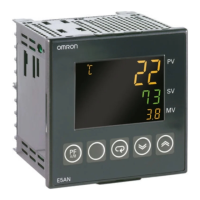VIII
Allow as much space as possible between the Digital Temperature Controller and devices that
generate powerful high frequencies (high-frequency welders, high-frequency sewing machines, etc.)
or surge.
8) Use this product within the rated load and power supply.
9) Make sure that the rated voltage is attained within two seconds of turning ON the power using a
switch or relay contact. If the voltage is applied gradually, the power may not be reset or output
malfunctions may occur.
10) Make sure that the Temperature Controller has 30 minutes or more to warm up after turning ON the
power before starting actual control operations to ensure the correct temperature display.
11) When using self-tuning, turn ON power for the load (e.g., heater) at the same time as or before
supplying power to the Digital Temperature Controller. If power is turned ON for the Digital Temper-
ature Controller before turning ON power for the load, self-tuning will not be performed properly and
optimum control will not be achieved.
12) A switch or circuit breaker should be provided close to this unit. The switch or circuit breaker should
be within easy reach of the operator, and must be marked as a disconnecting means for this unit.
13) Always turn OFF the power supply before pulling out the interior of the E5CN, E5AN, or E5EN, and
never touch nor apply shock to the terminals or electronic components. When inserting the interior of
the product, do not allow the electronic components to touch the case.
Always turn OFF the power supply before removing the terminal block from the E5GN, and never
touch nor apply shock to the terminals or electronic components.
14) Do not use paint thinner or similar chemical to clean with. Use standard grade alcohol.
15) Design system (control panel, etc) considering the 2 second of delay that the controller’s output to be
set after power ON.
16) The outputs may turn OFF when shifting to certain levels, such as the initial setting level. Take this
into consideration when performing control.
17) The number of EEPROM write operations is limited. Therefore, use RAM write mode when frequently
overwriting data during communications or others operations.
18) Always touch a grounded piece of metal before touching the Digital Temperature Controller to
discharge static electricity from your body.
19) Do not remove the terminal block from the E5CN, E5AN, or E5EN. Doing so may result in failure or
malfunction.
20) Control outputs that are voltage outputs are not isolated from the internal circuits. When using a
grounded thermocouple, do not connect any of the control output terminals to ground. (Doing so may
result in an unwanted circuit path, causing error in the measured temperature.)
21) When replacing the body of the E5CN, E5AN, or E5EN, check the condition of the terminals. If
corroded terminals are used, contact failure in the terminals may cause the temperature inside the
Digital Temperature Controller to increase, possibly resulting in fire. If the terminals are corroded,
replace the case as well.
When pulling out the terminal block of the E5GN to replace the Digital Temperature Controller, check
the condition of the terminals. If corroded terminals are used, contact failure in the terminals may
cause the temperature inside the Digital Temperature Controller to increase, possibly resulting in fire.
If the terminals are corroded, replace the terminal block as well.
22) Use suitable tools when taking the Digital Temperature Controller apart for disposal. Sharp parts
inside the Digital Temperature Controller may cause injury.
23) When applying Lloyd's standards, install the Digital Temperature Controller according to the require-
ments given in Shipping Standards in the E5CN, E5AN, E5EN, E5GN User’s Manual (Cat. No. H156).
24) Do not use the Temperature Controller if the front sheet is peeling or torn.

